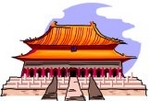
Worksheets and No Prep Teaching Resources
Reading Comprehension Worksheets
Ancient China

Ancient China
 Worksheets and No Prep Teaching Resources Reading Comprehension Worksheets Ancient China |
 Ancient China |
| edHelper's suggested reading level: | grades 8 to 12 | |
| Flesch-Kincaid grade level: | 7.95 |
|
Chinese Inventions - Compass & Gunpowder
By Vickie Chao |

|
 1 Have you ever had an idea that didn't quite turn out the way you intended? That "surprise" element is something inventors are very familiar with. A case in point is Leo Szilard (1898 - 1964), who patented the idea of a nuclear chain reaction in 1934. Though Leo Szilard came up with the idea and helped the U.S. government create the first atomic bomb, he was adamantly against using it on moral grounds. Despite his repeated pleas, the U.S. government dropped two atomic bombs on Japan in 1945 and ended World War II.
1 Have you ever had an idea that didn't quite turn out the way you intended? That "surprise" element is something inventors are very familiar with. A case in point is Leo Szilard (1898 - 1964), who patented the idea of a nuclear chain reaction in 1934. Though Leo Szilard came up with the idea and helped the U.S. government create the first atomic bomb, he was adamantly against using it on moral grounds. Despite his repeated pleas, the U.S. government dropped two atomic bombs on Japan in 1945 and ended World War II. |
Create Weekly Reading Books
Prepare for an entire week at once! |
| Leave your feedback on Chinese Inventions - Compass & Gunpowder (use this link if you found an error in the story) |
 |
Ancient China
|
 |
Social Studies
|